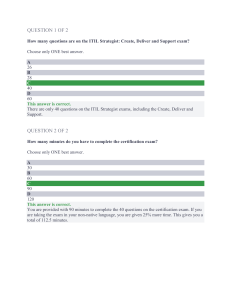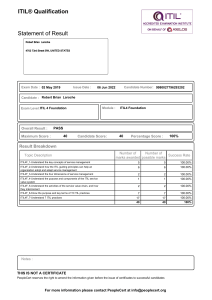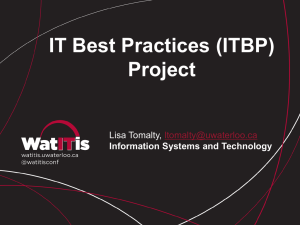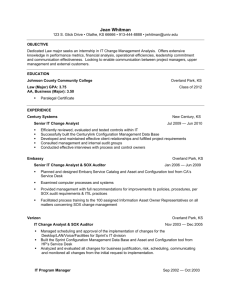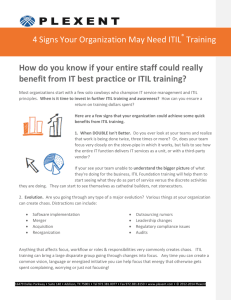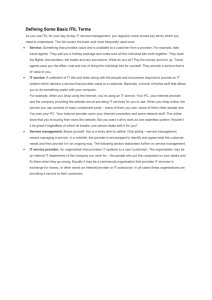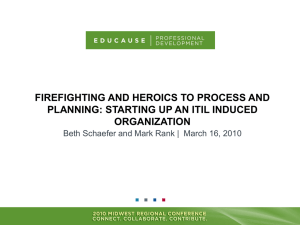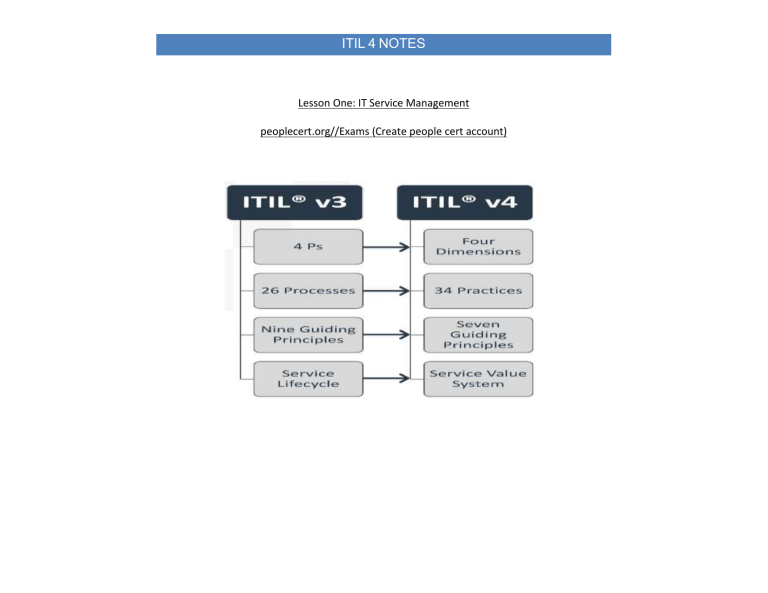
ITIL 4 NOTES Lesson One: IT Service Management peoplecert.org//Exams (Create people cert account) ITIL 4 NOTES Four P’s – People, Products, Partners, and Process Four Dimensions – Organizations & People, Information and Technology, Partners and Suppliers, and Value Streams & Processes Service Definition – The means of enabling value co-creation by facilitating outcomes that customers want to achieve without the customer having to manage specific costs and risks. Service Providers – Take on costs and risks, responsible for the means of achieving outcomes. ITIL 4 NOTES Customers – Transfers costs and risks, Retains focus on core business. Product Definition – A configuration of an organization’s resources designed to offer value for a consumer. Utility Definition – The functionality offered by a product or service to meet a particular need. (“What the service does” and whether it is “Fit for purpose”.) Warranty Definition – Assurance that a product or service will meet agreed requirements. Customer – Role that defines the requirements for a service and takes responsibility for the outcomes of service consumption. User – The role that uses services. Sponsor – Role that authorizes the budget for service consumption. Capability – The ability of an organization, person, process, application, configuration item, or IT service to carry out an activity. Resource – A person or entity that is required for the execution of an activity or the achievement of an objective. (The more mature a provider’s Capabilities and Resources are, the greater their ability to consistently produce quality services that meet the needs of the customers in a timely and cost-effective manner.) Organization – A person or a group of people that has its own functions with responsibilities, authorities, and relationships to achieve its objectives. Stakeholder – A person or organization that has an interest or involvement in an organization, product, service, practice, or other entity. ITIL 4 NOTES Value – The perceived benefits, usefulness, and importance of something. Value is regularly used in service management and is a key focus of ITIL 4; value must always be defined. Service Management – A set of specialized organizational capabilities for enabling value for customers in the form of services. Output – A tangible or Intangible deliverable of an activity. Outcome – A result for a stakeholder enabled by one or more outputs. Acting as a service provider, an organization produces outputs that help its consumers to achieve certain outcomes. (Desired Outcomes should always be defined) Cost – The amount of money spent on a specific activity or resource. 2 Types of costs involved in service relationships. Costs removed from the consumer by the service (a part of value proposition) Cost imposed on the consumer by the service (the costs of service consumption.) Both Types of costs are considered when the consumer assesses the value which they expect the service will create. Risk – A possible event that could cause harm or loss or make it more difficult to achieve objectives, the uncertainty of the outcome. 2 Types of risks that are of concern to service consumers. ITIL 4 NOTES Risks removed from a consumer by the service (part of the value proposition) Risks Imposed on a consumer by the service (risks of service consumption) It is the duty of the provider to manage the detailed level of risk on behalf of the consumer. Service Offering – A description of one or more services designed to address the needs of a target consumer group. Service Relationship – A cooperation between a service provider and service consumer. To create value, an organization must do more than simply provide a service. It must also cooperate with the consumers and build relationships. Service Provision – Activities performed by an organization to provide services. Service Provision includes: Management of the provider’s resources configured to deliver the service, access to these resources, fulfillment of the agreed service actions, service level management and continual improvement. Service provisions may also include the supply of goods. Service Consumption – Activities performed by an organization to consume services. Service Consumption Includes: Management of the consumer’s resources needed to use the service and service actions performed by users. Service consumption may also include the receiving (acquiring) of goods. Service relationship management: Joint activities performed by a service provider and a service consumer to ensure continual value co-creation based on agreed and available service offerings. ITIL 4 NOTES Lesson Two: Guiding Principles 7 Guiding Principles Focus on the Value Everything the organization does should link back directly or indirectly to value itself, its customers, and other stakeholders. It can achieve this by understanding: Who is the consumer? What are the consumer’s perspectives of value? How to improve the customer’s experience? Customer (CX) & User (UX) Experience – the sum of functional and emotional interactions with a service and service provider as perceived by a service consumer. Know how service consumers use each service. Encourage a focus on value among all staff. Focus on value during normal operational activity as well as during improvement initiatives. Include a focus on value in every step of any improvement initiative. Start where you are Do not start from scratch and build something new without considering what is already available. Implement “Start where you are” by: ITIL 4 NOTES Assessing where you are. Services and methods already in place should be observed to understand what can be reused from them. Decisions on how to proceed should be based on accurate information. The role of Measurement. The use of measurement is important to this principle. It should be used to support the analysis of what has been observed rather than to replace it, as over-reliance on data analytics and reporting can introduce biases and risks in decision making. Apply “Start Where You Are” Look at what exists as objectively as possible using the customer, or the desired outcome as the starting point. Determine if and how successful practices or services can be replicated or expanded upon to achieve the desired state. Apply your risk management skills. Recognize that sometimes nothing from the current state can be reused. Progress Iteratively With Feedback Do not attempt to do everything at once. Even huge initiatives must be accomplished iteratively. ITIL 4 NOTES Feedback Loop – A term commonly used to refer to a situation where part of the output of an activity is used for new input. In a well functioning organization, feedback is actively collected and processed along value chain. Use feedback before, throughout, and after each iteration. This ensures that actions are focused and appropriate, even if circumstances should change. Once received, feedback can be analyzed to identify Improvement opportunities, risks, and issues. Applying the principle Comprehend the whole but do something The ecosystem is constantly changing, feedback is essential. Fast does not mean incomplete. Time Boxing The goal of time boxing is to define and limit the amount of time dedicated to an iteration. Minimum viable product the most minimally featured thing you can build that will address the opportunity well enough for the most of your target customers. #4 Collaborate and Promote Visibility ITIL 4 NOTES Working together across boundaries produces results that have greater buy in, more relevance to objectives, and a better likelihood of long term success. Hidden agendas should be avoided, focus on trust, achieving objectives, understanding, shared information. Whom to collaborate with, communication for improvement, increasing urgency through visibility. Applying the Principle Collaboration does not mean consensus. Communicate in a way the audience can hear. Decisions can only be made on visible data. Insufficient visibility of work leads to poor decision making, which impacts the ability to improve internal capabilities. Perform critical analysis understand the flow of work progress. Identifying bottlenecks, as well as excess capacity. Uncovering Waste. Use Value Stream maps and Kanban boards #5 Think and Work Holistically (big picture, all points) ITIL 4 NOTES There are always limiting factors, identify and make good use of the limiting factors. No service or element used to provide a service, stands alone. All systems are connected there is nothing isolated, the organization works on the service as a whole. Results are delivered by integrating the four Dimensions: Information, technology, organization and people, practices and partners, and agreements, which should all be coordinated to provide a defined value. Applying the Principal Recognize the complexity of the systems. Collaboration is the key to thinking and working holistically. Where possible look for patterns in the needs of and interactions between system elements. Automation can facilitate working holistically. #6 Keep it Simple and Practical (if you don’t need it, get rid of it) If the process or service provides no value or useful outcome, eliminate it. In a process or procedure, use the minimum number of steps necessary to accomplish the objective. Always use outcome based thinking Judging what to keep conflicting objectives. ITIL 4 NOTES Applying the Principal Ensure value in every activity. Simplicity is the ultimate sophistication. Do fewer things but do them better. Respect the time of the people involved Simplicity is the best route to achieving quick wins. Easier to understand, more likely to adopt. #7 Optimize and Automate Resources of all types, particularly human resources (HR), should be used most effectively Eliminate anything that is truly wasteful and use technology to achieve whatever it is capable of. Human intervention should only happen where it really contributes value. The road to Optimization Understanding and agreeing on the context. This includes agreeing on the overall vision and objectives of the organizational. Assessing the current state of the optimization to understand where it can be improved and which improvement opportunities are likely to produce the biggest positive impact. ITIL 4 NOTES Agreeing what the future state and priorities of the organization should be, focus on simplification and value. Ensure optimization has the right level of stakeholder engagement and commitment. Execute improvements in an iterative way, check progress with feedback, adjust approach the optimization as needed. Continually monitoring the impact of optimization to identify opportunities to improve methods of working. Apply the principle Simplify and optimize before automating. Define your metrics. Use the other guiding principles when applying this one. End of Principles jj k k k k k ITIL 4 NOTES Lesson 3: Four Dimensions of Service Management Organizations and People #1 Ensure that the way an organization is structured and managed, as well as its roles, responsibilities, and systems of authority (Governance) and communication, are well-defined and support its overall strategy and operating model. People (whether its customers, employees of suppliers, employees of the service provider, etc.) are a key element in this dimension. Attention should be paid not only to the skills and competencies of teams or individual members but also to management and leadership styles and to communication and collaboration skills. Information and Technology #2 Information and knowledge necessary for service management, as well as the technologies required. (systems, security) Some examples are: Workflow management systems Knowledge Bases Inventory Systems Communication Systems ITIL 4 NOTES Analytical Tools Service management increasingly benefits from technology development. Security and Compliance to Privacy LIVE in computing solutions. Partners and Suppliers #3 Every organization and every service depends to some extent on services provided by other organizations. Contracts and agreements and relationships with 3rd parties. Value Streams and Processes #4 It defines the activities, workflows, controls, and procedures needed to achieve agreed objectives. Value Stream – A series of steps an organization undertakes to create and deliver products and services to consumers. Identifying and understanding the various value streams an organization has is critical to improving its overall performance Processes – A set of interrelated or interacting activities that transform inputs into outputs. A process takes one or more defined inputs and turns them into defined outputs. Processes define the sequence of actions and their dependencies. Process activities may include procedures (what and who) and work instructions (how). ITIL 4 NOTES The four dimensions represent a holistic approach. Ensure there is a balance of focus between each dimension All four dimensions and the external factors that affect them should be addressed as they evolve. The service value system is considered from all four dimensions. L Lesson 4: Service Value System Service Value system Overview For service management to function properly, It needs to work as a system The SVS describes the inputs (opportunity and demand), the elements (organizational governance, service management, continual improvement, and the organizations capabilities and resources), and the outputs (achievement of organizational objectives and value for the organization, its customers and other stakeholders). The ITIL SVS describes how all the components and activities of the organization work together as a system to enable value creation. The purpose of SVS is to ensure that the organization continually co-creates value with all stakeholders through the use and management products and services. Opportunities: represent options for possibilities to add value for stakeholders or otherwise improve the organization. Demand: the need or desire for products and services among internal and external customers. The SVS can enable the creation of many different types of value to a wide group of stakeholders. ITIL 4 NOTES The guiding principles are recommendations that can guide an organization in all circumstances, it helps make good (wise) decisions. Governance: the means by which an organization is directed and controlled. Governance evaluates, directs, and monitors all activities. Governance: The Evaluate Activity Governing body evaluates the organization’s: Strategy, portfolios, and relationships with other parties Governance: The Direct Activity Defines organizational strategies Sets the direction and prioritization. Organizational activity Future investment Policies establish the boundaries for behavior across the organization and with suppliers, partners, and other stake holders. What is permitted What is not permitted Organizations are then responsible to: Execute the strategy ITIL 4 NOTES Comply with the policies Training is a method to execute the strategies and policies to leverage compliance. Governance: The Monitor Activity Monitor organizational performance. Value streams, practices, products, and services to execute the strategy Compliance with policies via automation, inspections, and quality checks Use monitoring data as feedback for evaluation and direction Data may come from assessments, audits, benchmarks, and reports. The Role of Governance in the Service Value System Begins at the top but may have parts delegated (IT governance). Fundamental to the SVS and Subject to continual improvement. Uses ITIL guiding principles or tailors them as needed to meet organization needs. Needs to have visibility into improvement activities and value delivery. Guidelines for Establishing Governance in the Service Value System: Service value chain must work in line with direction given by the governing body. Governing body of the organization, either directly or through delegation of authority, maintains oversight of SVS. Governing body and management at all levels maintain alignment through a clear set of shared principles and objectives. Governance and management at all levels are continually improved to meet the expectations of the stakeholders. ITIL 4 NOTES Service Value Chain: a set of interconnected activities that an organization performs to deliver a valuable product or service to its consumers and facilitate value realization. Its an operating model for service providers that covers all the key activities required to effectively manage products and services. Value streams describe activities an organization takes in the creation of value: Convert inputs into outputs Activities may trigger other activities Value chain activities use different combinations of ITIL practices: internal or third party resources Processes, Skills and Competencies There are 5 components in the Service Value System There are 6 Practices in the Service Value Chain practices: Sets of organizational resources designed for performing work or accomplishing an objective. (make the service value chain work). Continual Improvement: a recurring organizational activity performed at all levels to ensure that organization’s performance continually meets stakeholder’s expectations. Lesson 5: Service Value Chain (PIEDOD) Service Value Chain: an operating model that outlines the activities required to respond to demand and facilitate value through the creation and management of products and services. There are 6 Activities in the Service Value Chain Plan: ensure shared understanding of vision, current status and improvement direction. Plan activities at all levels: strategic, architectural, program/project, and so on. The purpose of the plan chain activity is to ensure a shared understanding of the vision, current status, and improvement direction for all four dimensions and all products and services across the organization. ITIL 4 NOTES Inputs: Consolidated demands and opportunities by Engage Outputs: Strategic, tactical and operational plans, portfolio decisions, for design and transition, architectures and policies for design and transition, Improve: Ensure continual improvement. Execution of improvement activities and provision of improvement information Provide improvement plans and status. The purpose of Improve value chain activity is to ensure continual improvement of products, services, and practices all value chain activities and the four dimension of service management. Its the only activity that received from all other activities and sends to all other activities. Inputs: Deliver and Support , Engage, Design and Transition, Obtain and Build Outputs: Improvement initiatives and plans for all value chain activities. Plan, Design and Transition Engage: Understand stakeholder needs, facilitate transparency, and continually engage. Interactions include users, customers, suppliers, and other stakeholders. The purpose is to provide a good understanding of stakeholder needs, transparency, continual engagement, and good relationships with all stakeholders. Engage with different Stakeholders, primarily service consumers, using different practices (day to day collaboration, operational or tactical engagement through service level management, strategic and tactical engagement with sponsors, operational engagement with suppliers via supplier management practice. Inputs: Outputs: Consolidated demands and opportunities for Plan, requirements for Design and Transition, User support tasks for Deliver and Support Design and Transition: Ensure products and services meet expectations for cost, quality, and time to market (speed). Creation of new or changed solution designs; management and implementation of change. The purpose is to ensure that products and services continually meet stakeholder expectations for quality, costs, and time to market. ITIL 4 NOTES Inputs: Outputs: Obtain/Build: Acquisition or building of components, whether acquired from a third party or built in house. Ensure service components are available when and where needed per specifications. The purpose is to ensure that service components are available when and where they are needed and meet agreed specifications. Inputs: requirements and specifications provided by Design and Transition. Outputs: Service components for Deliver and support Service components for Design and Transition. Deliver and Support: Day to day delivery of solutions (outputs, Service Offerings); support for user needs related to the services. The purpose is to ensure that services are delivered and supported according to agreed specifications and stakeholders’ expectations. Inputs: New and Changed products and services provided by Design and Transition Outputs: Services delivered to customers and users, Information of completion of user support tasks for Engage. SVC Inputs and Outputs Inputs are received from other activities of the SVC. Outputs are produced and used elsewhere in the SVC. The Input/Output relationships: Are interconnected in a complex and dense manner. Support the interactions among all activities in the SVC The Input/Output relationships are not: Always Linear ITIL 4 NOTES Always one to one The Input/Output relationships can be: Linear One to One One to many many to one Lesson 6: ITIL Practices Overview ITIL Management Practices – A management practice is a set of organizational resources designed for performing work or accomplishing an objective. There are a total of 34 ITIL management practices, classified into general management practices (14), service management practices (17), and technical management practices (3). General management practices have been adopted/adapted for service management from general business management domains Service management practices have been developed in service management and ITSM industries Technical management practices have been adapted from technology management domains for service management purposes by expanding or shifting their focus from technology solutions to IT services. A SET of org RESOURCES is a PRACTICE A SET of org CAPABILITIES is a Service Management a CONFIGURATION of organization resources is a PRODUCT ITIL 4 NOTES Informatio n Security Management – The purpose is to protect the information needed by the organization to conduct its business. This includes understanding and managing risks to the confidentiality, integrity, and availability of information, as well as other aspects of information security such as authentication (ensuring someone is who they claim to be) and non-repudiation (ensuring that someone cant deny that they took an action). Confidentiality, Integrity, Availability, Information Security ISM operates primarily in three Phases: Prevent, Detect, Correct. Relationship Management – establish and nurture the links between the organization and its stakeholders at strategic and tactical levels. The relationship practice ensures that: Stakeholder’s needs and drivers are understood, and products and services are prioritized appropriately Stakeholders’ satisfaction is high, and a constructive relationship between the organization and stakeholders is established and maintained. ITIL 4 NOTES Customers’ priorities for new or changed products and services, in alignment with desired business outcomes are effectively established and articulated. Any Stakeholders’ complaints and escalations are handled well through a sympathetic (yet formal) process. Products and services facilitate value creation for the service consumers as well as for the organization. Organization facilitates value creation for the service consumers as well as for the organization. Organization facilitates value creation for all stakeholders, in line with the organization’s strategy and priorities. Conflicting stakeholder requirements are mediated appropriately. Supplier Management (Contractor, outsourcer, vendor, etc) – Ensure that the organization’s suppliers and their performance are managed appropriately to support the provision of seamless, quality products and services. Create closer, more collaborative relationships. Uncover and realize new value. Reduce risk of failure. Key activities include: Create a single point of visibility and control to ensure consistency. Maintain a supplier strategy, policy, and contract management information. Negotiate and agree on contracts and arrangements. (Clauses, Terms and conditions) Manage relationships and contracts wither internal and external suppliers. Manage supplier performance (to Service level agreements (SLA) targets). Contract renewal or termination. Supplier Models: In sourcing ITIL 4 NOTES outsourcing Single-Source/partnership Multi-sourcing It Asset Management – purpose is to plan and manage the full life cycle of all IT assets to help the organization: Maximize Value Control costs Manage risks Support decision making about the purchase Reuse the retirement of assets Meet regulatory and contractual requirements. IT Asset Management typically includes: Define, populate, and maintain the asset register in terms of structure and content, and the storage facilities for assets related media. Control the asset life cycle in collaboration with other practices (upgrading obsolete software or on boarding new staff members with a laptop and mobile phone) and record all changes to assets (status, location, characteristics, assignment, etc) Provide current and historical data, reports, and support to other practices about IT assets. Audit assets, related media, and conformity (particularly with regulations and license terms and conditions), and drive corrective and preventive improvements to deal with detected issues. IT Asset: Any valuable component that can contribute to the delivery of an IT product or service. Every asset is not a configuration item Monitoring and Event Management – The purpose is to systematically observe services and service components and record and report selected changes of state identified as events. ITIL 4 NOTES The monitoring part focuses on the systematic observation of services and the Cis that underpin services to detect conditions of potential significance. The event management part of the practice focuses on recording and managing those monitored changes of state that are defined by the organization as an event, determining their significance, and identifying and initiating the correct control action to manage them. Event – any change of state that has significance for the management of configuration item (CI) or IT service. Events are typically recognized through notifications created by an IT service, CI, or monitoring tool. Key Activities of an Event Management: What should be monitored, and establishing the monitoring strategy Implementing and maintaining monitoring Establishing and maintaining thresholds. Establishing and maintaining policies for event handling Implementing processes and automation. Detect the Change of state or status. Define its meaning. Determine the Control action. Release Management – Make new and changed services and features available for use. Release to the users to “use”. A release may comprise many different infrastructure and application components that work together to deliver new or changed functionality. It may also include documentation, training, (for users or IT staff), updated processes or tools, or any other components that are required Each component of release may be developed by the service provider or procured from a third party and integrated by the service provider. ITIL 4 NOTES Deployment always happens before release and deployment is always separate from release Service Configuration Management – Ensure that accurate and reliable information about the configuration of services and Cis that support them is available when and where it is needed. This includes information on how Cis are configured and relationships between them. Using a Configuration Management System (Database Tool), Service configuration management collects and manages information about a wide variety of CIs, typically including hardware, software, networks, buildings, people, suppliers, and documentation. Services are also treated as CIs, and configuration management helps the organization to understand how they the many CIs that contribute to each service work together. ITIL 4 NOTES Configuration Item: Any Component that needs to be managed in order to deliver an IT service. Every configuration item is an asset. Deployment Management – To move new or changed hardware, software, documentation, processes, or any other component to live environments. We deploy components and we release services. It may also be involved in deploying component to other environments for testing or staging. Works closely with Release Management and Change Enablement but is a separate practice. Deployment and Release methods include: Big bang vs phased manual vs continuous (automated) delivery Push vs Pull How Deployment is Evolving: deployment is a high risk event change errors are a major cause of incidents new practices, such as Agile and DevOps, attempt to make deployment activities more routine and frequent to minimize incidents and errors. Additional technical practices that have been successful include: Automating the deployment pipeline Emphasizing high quality. Using automated testing methods. Using small batch sizes. Maintaining rigorous version control of application and environments. ITIL 4 NOTES
